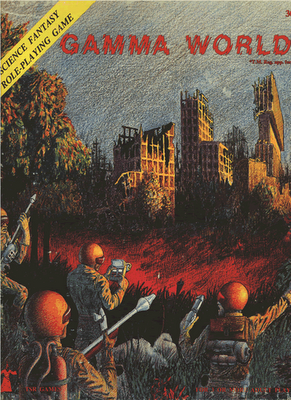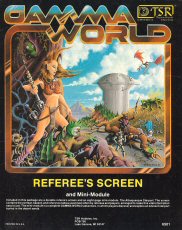The ink on Metamorphosis Alpha wasn’t even dry before Jim Ward was turning to Gamma World. The Warden was no longer an isolated catastrophe; the canvas had expanded—or rather, shifted—and the Earth that sent that ship forth had collapsed back into the dark ages. Savvy designer that he was, Ward extended our world’s timeline out from the present some two hundred years so as to allow for the wreckage of a shiny futuristic society rather than just some shabby mirror of our own.
Though it seemed familiar enough anyway. For us children of the cold war, nuclear destruction was always just around the corner, and Gamma World was well positioned to tap into a rich vein of cultural anxiety. But whereas books and movies about the apocalypse were a dime a dozen, it took science fiction to envision the aftermath amidst the ruins. Ward had plenty of choices for inspiration here; chief among these were Andre Norton’s enduring classic Star Man’s Son and Brian Aldiss’ Hothouse (just as that latter writer’s Nonstop had influenced the predicament of the Warden). From these influences emerged something raw and savage, shot through with the same kind of mad zaniness that had pervaded Metamorphosis Alpha.
As with that prequel, the mutation tables were key to defining one’s own place in this brave new world. There was a certain chic factor in playing a pure strain human (as well as the chance to stuff yourself into one of those suits of powered armor), but the interesting characters tended to be mutated. And the really interesting ones were animals. I have particularly fond memories of a friend’s character—one “Colonel W.E.” Texarkana, a mutated rabbit who managed to be the lone survivor more than once. One of the Colonel’s erstwhile colleagues was the can-you-tell-he’s-been-named-by-a-seventeen-year-old Ganja Weed, who took advantage of a lax gamemaster’s decision to allow mutated plants to be PCs, causing no end of hilarity until Ganja Weed was destroyed by a fusion bomb in the name of overkill. As with Metamorphosis Alpha, life in in Gamma World tended to be exciting and short.
But by no means devoid of larger purpose. One of the more interesting questions in post-apocalyptic milieus is whether or not the cause of the collapse matters. A work like Cormac McCarthy’s The Road would argue that it doesn’t; for those simply seeking to survive, this is undoubtedly true. Yet for those hoping to tap the power and the knowledge of the Ancients, the gestalt of collapse figures hugely—and the first editions of Gamma World were particularly intriguing here, the lore of a lost Apocalypse base giving GMs the option of building a campaign around the search for the HQ of those who had initiated the beginning of Earth’s end. One even had the potential to get off-planet; the GW timeline referenced an extensive space-based architecture (including the legendary TransPlutonian Shipyards that had launched the Warden), and Ward himself wrote in detail about the Moon’s Tycho Base in Dragon issue #86. (The article doesn’t seem to be online, but you can pick up that particular issue for less than five bucks over at Amazon. And I’m suddenly struck with a wave of nostalgia at the long lost cover, my copy having sheds its own years ago.)
That same off-world direction was continued subsequent to the cancellation of the third edition when another, unofficial module picked up what TSR had given up on. Omega Project was written by a fan, but stacks up pretty well even against professional content. Indeed, Gamma World is notable for inspiring robust creations on the part of its followers. Take a few minutes to click through this campaign setting for the New West/New South to see another of the more impressive efforts….of course, Omega Project would never have been necessary had TSR not pulled the plug, a problem that plagued Gamma World across its iterations. One can only hope that the impending seventh edition doesn’t suffer the fate of its predecessors, but presumably that will be a function of how well it sells and/or corporate politics.

For me, though, that first edition will remain the touchstone, for reasons that pertain less to game design/quality than they do to Peter Graham’s comment about the golden age of science fiction. That cover of a group of adventurers standing on the edge of a ruined city takes me back every time . . a #$#-up future dimly visible at the horizon of my own past—but I suppose that’s only fitting, because ultimately the essence of Gamma World was how it so deftly rendered the familiar alien through the lens of uncertain hindsight. It was, after all, the first RPG that you could literally set in your backyard—many a Gamma World campaign featured the gamers’ local town/environment, a tradition started by Gary Gygax himself when he situated the first GW module, Legion of Gold, in the vicinity of a nuked-out Lake Geneva. And the ingeniously-crafted artifact charts meant that players could spend whole hours trying to get some arcane device to work, only to discover that they’d been wasting their time with a toaster. Or that they’d just blown their heads off with a death-ray….D&D may have outsold Gamma World many times over, but in this sense at least the latter did a better job of making us feel the fear of the unknown. At least with a magic sword you always knew which end you should be holding.
David J. Williams is the author of the Autumn Rain trilogy (The Mirrored Heavens, The Burning Skies, and the just-released The Machinery of Light). More about the world of the early 22nd century at www.autumnrain2110.com.










